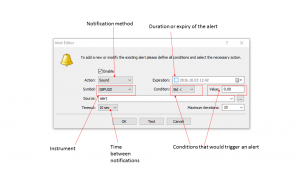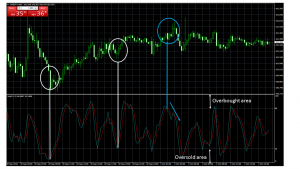20.02.2017
Forex Alerts & Timely Trading

The modern Forex market is fountain of data and information that is distributed to almost every corner of the world via the internet and social media networks. The Forex markets operate 24 hours a day, 5 days a week across the globes financial centres. These markets encompass dozens of FX pairs and crosses, whose prices react continuously to a constant stream of data, order flow and sentiment changes. In truth there is far too much information generated in today’s Forex markets for any one individual to consume and sensibly comprehend. Apart from anything else we all need to sleep sometime.
Luckily help is on hand and systems and tools exist which allow traders to filter this information stream and to make sense of the markets.
Too much data
However dedicated and sharp eyed a trader may be it would be almost impossible for them to watch and react to the all price changes in the 60 or so trading instruments that Blackwell Global offers to its clients. Traders will often have preferred instruments that they regularly trade, in this way they narrow down the list of items they need to watch and be aware of.
These instruments may be selected on the basis of geography and time zone or because a trader feels they have an affinity with or an understanding of the drivers of given FX pairs or crosses. But this selection could also be driven by activity for example a trader may choose to concentrate on the most highly traded instruments. Which could comprise EUR USD, USD JPY and GBP USD. But even having narrowed down the list of markets we wish to watch we will still need to consider how the constituents may behave over multiple time frames that is 1, 5, 15, 30 and 60 minute periods etc as well as daily and weekly time frames.
Plotting the future
One way that traders can achieve this is through the use of Technical Analysis (or TA) which is the study of price and (when available) volume. Technical Analysts mostly study charts, which are a graphical plot of the price action of a given instrument over a defined period of time.
The Technical Analyst looks for information contained within the plot of a chart that may reveal key price points, recognisable patterns and formations, alongside repetitive behaviour.
The TA practitioner will try to use this information to predict what will happen to the price of that instrument going forward and to identify key price points that could either confirm or reject this hypothesis. Having identified these key levels a trader might wish to be notified as and when an instrument’s price reaches or breaches them.
Customise Forex Alerts
One way to achieve that would be to set a notification to be triggered at a specific price.The Blackwell Trader MT4 platform contains just such a function called “Alert Editor”.
An example of which can be seen below. Clients can use this tool to configure a custom Forex Alert. They can choose the instrument on which to place the alert and nominate the actions that would trigger the alert. For instance the bid price of the instrument falling below a certain value, as well as configuring the duration and frequency of the alert. For example the alert might be set to expire towards the end of the current day. With notifications (in this instance a distinctive sound) set to go off every 10 seconds, for a maximum of 10 instances, if and when the Forex Alert conditions are met.
You can create and edit multiple alerts and a handy counter in the system records when and how many times each individual alert has been triggered.
Other Forex Alerts
Those traders who follow and use Technical Analysis deploy a whole range of tools and studies to create Forex Alerts. These range from the use of simple or weighted moving averages to more complicated studies, such as stochastics and oscillators. The purpose behind the deployment of a simple or even a sophisticated study or tool is to determine what is happening to the price of an instrument ,as well as the supply and demand activity or sentiment that surrounds it. In this way traders hope to create a Forex Alert that will provide them with a competitives or comparative advantage over their peers
The stochastic indicator was devised by George Lane in the 1950s. Mr Lane maintained that his indicator did not follow price or volume, but rather that it followed the speed or momentum of price. It was created in the belief that such momentum experiences a change in direction, ahead of a change in direction of the price itself. As such the indicator should show traders when a price was looking overbought or oversold creating an ideal tool for Forex Alerts.
A stochastic chart (see below)
The stochastic indicator is displayed in a sub window to the main price chart and consists of two lines known as %D (a green line) and %K (a red line). These lines compare the current high and low price performance, to that seen in an instrument over a specified prior period. The indicator has oversold and overbought boundaries set at 80% and 20% respectively and divergence between the direction of the indicator and the price, particular at or around these extremes form clear Forex Alerts for traders.
The chart above is a USD JPY 15 minute chart with the stochastic indicator applied in the lower window. We have highlighted two areas, in white, where, the price of Dollar Yen rises immediately after the indicator moves to or through its oversold reading of 20.
We have highlighted a third area in blue, where the price of Dollar Yen continues to rise (before a subsequent sell off) despite the fact that the stochastic indicator had reached and was retreating from its overbought level (annotated by the blue arrow).
This is an instance of the divergence we mentioned above and it’s also prime example of how an indicator like this can be used to create a Forex Alert.
Forex Alerts from other sources
There are many more tools and indicators that can be used to create Forex Alerts for traders and highlight trading opportunities. But Technical Analysis is not the only source of Forex Alerts. It is often said that “Forex is Global Macro” what this means is that high level, top down, economic data are one the main drivers of changes in price and trends in Forex markets. It follows therefore that a study of this economic data could yield valuable information.This discipline is known as Fundamental Analysis.
Modern developed and developing economies produce regular economic data releases. Which can be compared to both their own historic performance and the data from their peers. Many of these releases are well researched and as a result of this analysts form a consensus forecast for the data, ahead of its release. If the data deviates widely on release from either this forecast or the trend in the time series data that preceded it, then this can form a useful Forex Alert for traders.
Traders can track data releases through the economic calendar on the Blackwell Global website. This can be filtered to display events relevant to a currency or group of currencies, or by the expected level of importance or market impact of a release.The calendar also contains a rolling countdown of the time left to a data release and highlights imminent data one minute before the news is due.
Discover which Forex Alerts are right for you
Which Forex Alerts you decide to use and how you generate them will depend on your own personal approach to the market and the time frames over which you trade. But whether you are short or longer term trader, favour Technical Analysis or study Fundamental data. You can refine your approach and discover Forex Alerts that best suit you via our risk free demo trading account Which allows you trade a highly realistic simulation of the live markets without risking any real cash. You can test and refine your Forex Alerts strategy, however long it takes and once you have a formula that works for you can apply for a Live trading account and trade the real markets using those Forex Alerts.
Back to Previous Page >>


